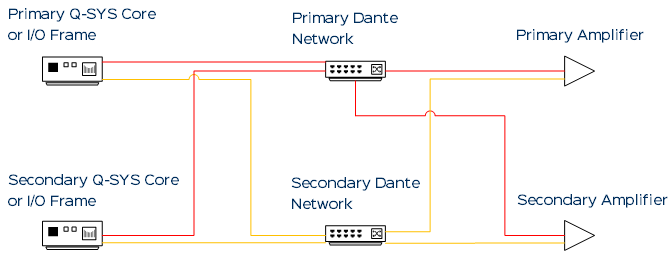Dante Audio
Read this topic to understand the network requirements for Dante hardware and the Software Dante components in Q-SYS Designer Software.
When using the Software Dante TX and Software Dante RX components, observe these clocking requirements, which are all configurable in Design Properties:
- Configure the Software Dante Receive Latency to compensate for network latency variation.
- If you require the Q-SYS Core to be the clocking Preferred Master, you cannot set this flag in Dante Controller. Instead, configure the Q-SYS Designer > Design Properties > PTP Priority 1 property to be <= 127 and ensure that no other devices have 'Preferred Master' checked in Dante Controller.
Refer to the Design Properties topic for explanations of these properties.
In Design Properties, you can choose DSCP Quality of Service (QoS) markings to apply to various Q-SYS data types. These DSCP markings help the network switch prioritize these data types alongside other network traffic. To assign DSCP values within your Q-SYS design, navigate to File > Design Properties in Q-SYS Designer, where you can select from Q-LAN, Audinate, and Manual presets.
When your network includes Dante traffic, it is strongly recommended to use the Audinate QoS preset (as it tells Q-SYS Designer to align DSCP markings with Audinate's) unless you are using a Q-SYS NS Series Network Switch. For guidance on selecting the appropriate switch for your network, refer to the Network Switches & Infrastructure documentation.
Tip: For further information on integrating Dante into your network and configuring QoS, consult the documentation on Audinate's website.
Software Dante requires the mDNS protocol. This protocol is automatically enabled on the LAN adapter configured for Software Dante (in Design Properties > Software Dante > Interface) whenever Software Dante is included in a running design.
Tip: To learn how to configure what LAN interfaces to use for Software Dante, see Design Properties.
Redundancy Requirements for CDN64 Cards
To achieve redundancy with the CDN64 – Dante Audio Bridge Card, observe these requirements:
- Ensure that the two CDN64 cards are installed in a redundant pair of Q-SYS Cores or I/O Frames.
- In the Q-SYS Dante components (Dante In, Dante Out), set the External Configuration property to 'No' – i.e., internal control mode.
- Configure all routing, in and out, using the Q-SYS Dante components. If you have a third-party device that receives a Dante stream from the CDN64 card, make that connection as you normally do (for example, with Dante Controller).
- If you have configured a static IP address on the primary card, you must also configure a static IP on the backup card (configurable in Dante Controller). Since only one card is active at a time, a static address can be the same for both cards.
Note: Dante Domain Manager version 1.1.0 (supported by Dante firmware 4.2.0) is the first DDM version that is compatible with a redundant CDN64 card configuration.
Redundancy Requirements for Software Dante
- The Q-SYS Core's primary (LAN A) and secondary (LAN B) network interfaces must be isolated by completely separate network infrastructures or VLANs with no routing between them.
- The Q-SYS Designer > File > Design Properties > Software Dante > Interface property must be set to 'Both'. Refer to the Design Properties topic.
- If DHCP server IP address assignment is not used on the Q-SYS network, the Q-SYS Core's LAN B network interface must be statically assigned an IP address within 172.31.x.x/16. This is because Dante devices use this IP range for link-local connections on the secondary network. Use Q-SYS Core Manager to configure IP addressing – see the Q-SYS Core Manager > Network > Basic topic.
- Each Q-SYS Core must have its own unique Software Dante license installed. Refer to the Q-SYS Core Manager > Licensing topic.
Failover
When a failover occurs, all the Dante control values are copied to the backup. Any 3rd-party device configured to receive Dante streams automatically reconnects, as the Device Name and Channel names and labels stay the same.

